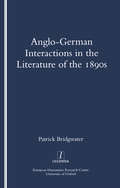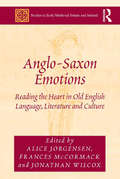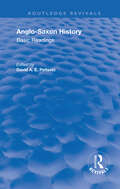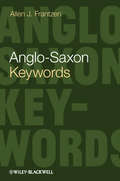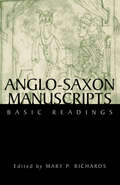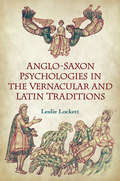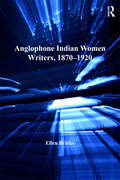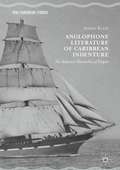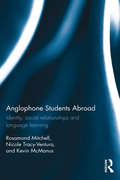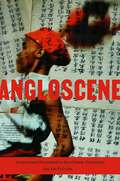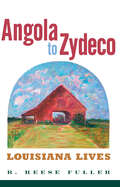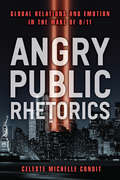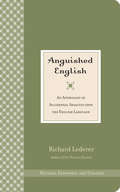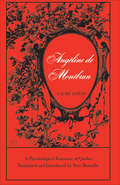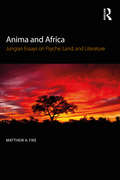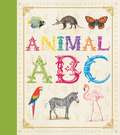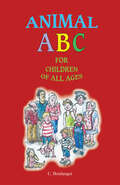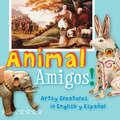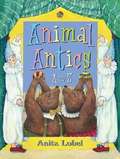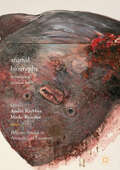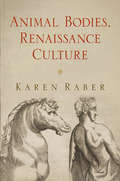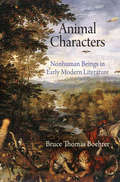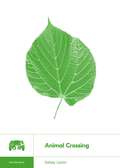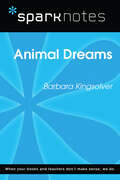- Table View
- List View
Anglo-German Interactions in the Literature of the 1890s
by Patrick Bridgwater"This is a study of what the main ""aesthetic"" writers of late 19th-century Britain made of German literature, and of how Germany in turn reacted to them. The impact of Anglo-Scottish art nouveau in fin-de-siecle Austria and Germany made it predictable that Keats, Pater and Rossetti, among others, would be well received, but no one could have known in advance that by the time of their deaths, Swinburne and Wilde would be more highly regarded in Germany than in Britain. Bridgwater's documented study casts light on the central cultural issues of the day, including ideas of morality, truth and subjectivism in art, comparing Pater and Wilde with Nietzsche, and George Moore, that chameleon of the decadent 90s, with Schopenhauer."
Anglo-Saxon Emotions: Reading the Heart in Old English Language, Literature and Culture (Studies in Early Medieval Britain and Ireland)
by Alice Jorgensen Frances McCormack Jonathan WilcoxResearch into the emotions is beginning to gain momentum in Anglo-Saxon studies. In order to integrate early medieval Britain into the wider scholarly research into the history of emotions (a major theme in other fields and a key field in interdisciplinary studies), this volume brings together established scholars, who have already made significant contributions to the study of Anglo-Saxon mental and emotional life, with younger scholars. The volume presents a tight focus - on emotion (rather than psychological life more generally), on Anglo-Saxon England and on language and literature - with contrasting approaches that will open up debate. The volume considers a range of methodologies and theoretical perspectives, examines the interplay of emotion and textuality, explores how emotion is conveyed through gesture, interrogates emotions in religious devotional literature, and considers the place of emotion in heroic culture. Each chapter asks questions about what is culturally distinctive about emotion in Anglo-Saxon England and what interpretative moves have to be made to read emotion in Old English texts, as well as considering how ideas about and representations of emotion might relate to lived experience. Taken together the essays in this collection indicate the current state of the field and preview important work to come. By exploring methodologies and materials for the study of Anglo-Saxon emotions, particularly focusing on Old English language and literature, it will both stimulate further study within the discipline and make a distinctive contribution to the wider interdisciplinary conversation about emotions.
Anglo-Saxon History: Basic Readings
by David A. E. PelteretFirst published in 2000, Basic Readings in Anglo-Saxon England (BRASE) is a series of volumes that collect classic, exemplary, or ground-breaking essays in the fields of Anglo-Saxon studies generally written in the 1960s or later, or commissioned by a volume editor to fulfill the purpose of the given volume. This, the sixth volume in the series, is the first devoted to history and the first edited by a scholar outside the field of literary study. David Pelteret has collected fifteen previously published essays: the first nine of his essays present a conspectus of Anglo-Saxon history; the other seven are spread among seven "Special Approaches": Anthropology, Archaeology, Art History, Economic and Comparative History, Geography and Geology, Place-Names, and Topography and Archaeology.
Anglo-Saxon Keywords (Keywords in Literature and Culture (KILC). #2)
by Allen J. FrantzenAnglo-Saxon Keywords presents a series of entries that reveal the links between modern ideas and scholarship and the central concepts of Anglo-Saxon literature, language, and material culture. Reveals important links between central concepts of the Anglo-Saxon period and issues we think about today Reveals how material culture—the history of labor, medicine, technology, identity, masculinity, sex, food, land use—is as important as the history of ideas Offers a richly theorized approach that intersects with many disciplines inside and outside of medieval studies
Anglo-Saxon Manuscripts: Basic Readings (Basic Readings in Chaucer and His Time)
by Mary P. RichardsThe study of manuscripts is fundamental to the appreciation of Anglo-Saxon texts and culture. Anglo-Saxon Manuscripts: Basic Readings provides an introductory collection of materials covering basic terms, techniques, resources, issues, and applications. Focusing on manuscripts copied before 1100 in England, the selections gathered here consider their history, production, analysis, and significance. Drawn from a variety of published sources and new writings commissioned for this collection, these essays offer a thorough background in principles and practices, along with up-to-date coverage of new developments in paleography. This interdisciplinary collection introduces key subjects of research for Anglo-Saxon studies while suggesting potential developments and new directions within the field.
Anglo-Saxon Psychologies in the Vernacular and Latin Traditions
by Leslie LockettOld English verse and prose depict the human mind as a corporeal entity located in the chest cavity, susceptible to spatial and thermal changes corresponding to the psychological states: it was thought that emotions such as rage, grief, and yearning could cause the contents of the chest to grow warm, boil, or be constricted by pressure. While readers usually assume the metaphorical nature of such literary images, Leslie Lockett, in Anglo-Saxon Psychologies in the Vernacular and Latin Traditions, argues that these depictions are literal representations of Anglo-Saxon folk psychology.Lockett analyses both well-studied and little-known texts, including Insular Latin grammars, The Ruin, the Old English Soliloquies, The Rhyming Poem, and the writings of Patrick, Bishop of Dublin. She demonstrates that the Platonist-Christian theory of the incorporeal mind was known to very few Anglo-Saxons throughout most of the period, while the concept of mind-in-the-heart remained widespread. Anglo-Saxon Psychologies in the Vernacular and Latin Traditions examines the interactions of rival - and incompatible - concepts of the mind in a highly original way.
Anglophone Indian Women Writers, 1870–1920
by Ellen BrinksThe result of extensive archival recovery work, Ellen Brinks's study fills a significant gap in our understanding of women's literary history of the South Asian subcontinent under colonialism and of Indian women's contributions and responses to developing cultural and political nationalism. As Brinks shows, the invisibility of Anglophone Indian women writers cannot be explained simply as a matter of colonial marginalization or as a function of dominant theoretical approaches that reduce Indian women to the status of figures or tropes. The received narrative that British imperialism in India was perpetuated with little cultural contact between the colonizers and the colonized population is complicated by writers such as Toru Dutt, Krupabai Satthianadhan, Pandita Ramabai, Cornelia Sorabji, and Sarojini Naidu. All five women found large audiences for their literary works in India and in Great Britain, and all five were also deeply rooted in and connected to both South Asian and Western cultures. Their works created new zones of cultural contact and exchange that challenge postcolonial theory's tendencies towards abstract notions of the colonized women as passive and of English as a de-facto instrument of cultural domination. Brinks's close readings of these texts suggest new ways of reading a range of issues central to postcolonial studies: the relationship of colonized women to the metropolitan (literary) culture; Indian and English women's separate and joint engagements in reformist and nationalist struggles; the 'translatability' of culture; the articulation strategies and complex negotiations of self-identification of Anglophone Indian women writers; and the significance and place of cultural difference.
Anglophone Literature of Caribbean Indenture: The Seductive Hierarchies of Empire (New Caribbean Studies)
by Alison KleinThis book is the first comprehensive study of Anglophone literature depicting the British Imperial system of indentured labor in the Caribbean. Through an examination of intimate relationships within indenture narratives, this text traces the seductive hierarchies of empire – the oppressive ideologies of gender, ethnicity, and class that developed under imperialism and indenture and that continue to impact the Caribbean today. It demonstrates that British colonizers, Indian and Chinese laborers, and formerly enslaved Africans negotiated struggles for political and economic power through the performance of masculinity and the control of migrant women, and that even those authors who critique empire often reinforce patriarchy as they do so. Further, it identifies a common thread within the work of those authors who resist the hierarchies of empire: a poetics of kinship, or, a focus on the importance of building familial ties across generations and across classifications of people.
Anglophone Students Abroad: Identity, Social Relationships, and Language Learning
by Rosamond Mitchell Kevin McManus Nicole Tracy-VenturaAnglophone students abroad: Identity, social relationships and language learning presents the findings of a major study of British students of French and Spanish undertaking residence abroad. The new dataset presented here provides both quantitative and qualitative information on language learning, social networking and integration and identity development during residence abroad. The book tracks in detail the language development of participants and relates this systematically to individual participants’ social and linguistic experiences and evolving relationship. It shows that language learning is increasingly dependent on students’ own agency and skill and the negotiation of identity in multilingual and lingua franca environments.
Angloscene: Compromised Personhood in Afro-Chinese Translations
by Jay Ke-SchutteA free ebook version of this title is available through Luminos, University of California Press’s Open Access publishing program. Visit www.luminosoa.org to learn more.Angloscene examines Afro-Chinese interactions within Beijing's aspirationally cosmopolitan student class. Jay Ke-Schutte explores the ways in which many contemporary interactions between Chinese and African university students are mediated through complex intersectional relationships with whiteness, the English language, and cosmopolitan aspiration. At the heart of these tensions, a question persistently emerges: How does English become more than a language—and whiteness more than a race? Engaging in this inquiry, Ke-Schutte explores twenty-first century Afro-Chinese encounters as translational events that diagram the discursive contours of a changing transnational political order—one that will certainly be shaped by African and Chinese relations.
Angola to Zydeco: Louisiana Lives
by R. Reese FullerAngola to Zydeco: Louisiana Lives is a collection of creative nonfiction pieces about the lively personalities who call south Louisiana home. Originally published in newspapers based in Lafayette—Times of Acadiana and Independent Weekly—the twenty-five profiles and features provide intriguing glimpses into the lives of well-known Louisianans such as James Lee Burke, Ernest J. Gaines, Elemore Morgan Jr., Buckwheat Zydeco, Marc Savoy, Boozoo Chavis, Calvin Borel, Santy Runyon, and Eddie Shuler. Author R. Reese Fuller also details the sometimes zany and sometimes tragic subjects that populate the cultural landscape of south Louisiana, from Tabasco peppers to Angola prison to cockfighting. Fuller brings years of experience in the newspaper industry to bear on this collection, offering behind-the-scenes access not available elsewhere. Of particular note are his interviews with musicians and local celebrities, who reveal how their love of the region has influenced their work. Fuller’s natural approach to storytelling creates a book that is a joy to read and truly represents the people of south Louisiana.
Angry Planet: Decolonial Fiction and the American Third World
by Anne StewartBefore the idea of the Anthropocene, there was the angry planet How might we understand an earthquake as a complaint, or erosion as a form of protest—in short, the Earth as an angry planet? Many novels from the end of the millennium did just that, centering around an Earth that acts, moves, shapes human affairs, and creates dramatic, nonanthropogenic change.In Angry Planet, Anne Stewart uses this literature to develop a theoretical framework for reading with and through planetary motion. Typified by authors like Colson Whitehead, Octavia Butler, and Leslie Marmon Silko, whose work anticipates contemporary critical concepts of entanglement, withdrawal, delinking, and resurgence, angry planet fiction coalesced in the 1990s and delineated the contours of a decolonial ontology. Stewart shows how this fiction brought Black and Indigenous thought into conversation, offering a fresh account of globalization in the 1990s from the perspective of the American Third World, construing it as the era that first made connections among environmental crises and antiracist and decolonial struggles.By synthesizing these major intersections of thought production in the final decades of the twentieth century, Stewart offers a recent history of dissent to the young movements of the twenty-first century. As she reveals, this knowledge is crucial to incipient struggles of our contemporary era, as our political imaginaries grapple with the major challenges of white nationalism and climate change denial.
Angry Public Rhetorics: Global Relations and Emotion in the Wake of 9/11 (Configurations: Critical Studies Of World Politics)
by Celeste Michelle ConditIn Angry Public Rhetorics, Celeste Condit explores emotions as motivators and organizers of collective action—a theory that treats humans as “symbol-using animals” to understand the patterns of leadership in global affairs—to account for the way in which anger produced similar rhetorics in three ideologically diverse voices surrounding 9/11: Osama bin Laden, President George W. Bush, and Susan Sontag. These voices show that anger is more effective for producing some collective actions, such as rallying supporters, reifying existing worldviews, motivating attack, enforcing shared norms, or threatening from positions of power; and less effective for others, like broadening thought, attracting new allies, adjudicating justice across cultural norms, or threatening from positions of weakness. Because social anger requires shared norms, collectivized anger cannot serve social justice. In order for anger to be a force for global justice, the world’s peoples must develop shared norms to direct discussion of international relations. Angry Public Rhetorics provides guidance for such public forums.
Anguished English: An Anthology of Accidental Assaults Upon the English Language
by Richard LedererThe &“impossible to put down&” compendium of linguistic bloopers and blunders: a hilarious collection of malapropisms, mixed metaphors and more (San Francisco Chronicle).In Anguished English, Richard Lederer collects some of the worst—and funniest—English language errors ever committed to print. From legendary student screwups to horrible headlines and cringe-worthy advertising copy, Lederer shares a treasure trove of laugh-out-loud flubs and gaffes worthy of a Pullet Surprise.&“Hilarious.&”—Chicago Tribune&“Richard Lederer is the true king of language comedy. Anguished English is the funniest book I have ever read.&”—Sidney Sheldon
Angéline de Montbrun: A Psychological Romance of Quebec
by Laure Conan Yves BrunelleLaure Conan was the first woman novelist in French Canada and the first writer in all Canada to attempt a roman d'analyse. As she refused to have her true identity revealed, the author of the preface to her book, Abbé H.-R. Casgrain, made a point of confirming that it was indeed a woman hiding behind the pen-name. Her daring in writing a psychological novel was 'forgiven' because she was a woman, and her anticipating the trend towards this type of novel was attributed to 'that intuition natural to her sex.' In Angéline de Montbrun, Laure Conan broke with what has been called the 'collective romanticism' of nineteenth-century French-Canadian land, with the rural myth, the exhortative tone, and the vast canvas. These concerns are basically absent in her work. Further, she eschewed the details of adventure and intrigue, the wooden, predictable characters, and the transparent intricacies of romantic love in favour of writing about the inner turmoil of an individual, live character, a young woman caught in a complex web of human appetites, aspirations, and relationships. Because of the novel's realism, one of the most persistent topics of discussion about Laure Conan has been whether or not Angéline de Montbrun is autobiographical. Recent studies indicate it may be. In any case, Angéline was the most complex character in Canadian fiction to 1882 and for some time to come. Traditionally, Angéline de Montbrun was regarded as a novel of Christian renunciation, and Angéline as the most holy of heroines. For a long time no one went too deeply into the relationships between the characters, but in 1961 Jean Le Moyne bluntly stated that 'the lovers in the novel are not Maurice Darville and Angéline, but M. de Montbrun and his daughter.' Since then there has been a proliferation of interpretations and psychological studies of the novel, and there is no going back to the simpler view of it.
Anima and Africa: Jungian Essays on Psyche, Land, and Literature
by Matthew A. FikeC. G. Jung understood the anima in a wide variety of ways but especially as a multifaceted archetype and as a field of energy. In Anima and Africa: Jungian Essays on Psyche, Land, and Literature, Matthew A. Fike uses these principles to analyze male characters in well-known British, American, and African fiction. Jung wrote frequently about the Kore (maiden, matron, crone) and the "stages of eroticism" (Eve, Mary, Helen, Sophia). The feminine principle’s many aspects resonate throughout the study and are emphasized in the opening chapters on Ernest Hemingway, Henry Rider Haggard, and Olive Schreiner. The anima-as-field can be "tapped" just as the collective unconscious can be reached through nekyia or descent. These processes are discussed in the middle chapters on novels by Laurens van der Post, Doris Lessing, and J. M. Coetzee. The final chapters emphasize the anima’s role in political/colonial dysfunction in novels by Barbara Kingsolver, Chinua Achebe/Nadine Gordimer, and Aphra Behn. Anima and Africa applies Jung’s African journeys to literary texts, explores his interest in Haggard, and provides fresh insights into van der Post’s late novels. The study discovers Lessing’s use of Jung’s autobiography, deepens the scholarship on Coetzee’s use of Faust, and explores the anima’s relationship to the personal and collective shadow. It will be essential reading for academics and scholars of Jungian and post-Jungian studies, literary studies, and postcolonial studies, and will also appeal to analytical psychologists and Jungian psychotherapists in practice and in training.
Animal ABC
by Susi MartinAn introduction to the alphabet and the animal kingdom. This charming book introduces children to every letter in the alphabet. Beautiful watercolor illustrations on every page will engage and delight children, with a variety of animals for children to spot, from aardvarks and alligators to zebras. Children love animals and take pride in identifying them. Animal ABC is sure to engage young minds.
Animal ABC for Children of All Ages
by C. BoulangerWhen COVID-19 lockdowns swept the globe, creativity unlocked for one woman in Belleville, Ontario. Alone with her cat, C. Boulanger turned to a fantasy world she had long imagined, bringing to life a charming children&’s tale. With whimsical animals as guides straight from her isolation, she penned Animal ABC for Children of All Ages not just to delight young readers, but to remind all of us that even in the darkest of days, joy and wonder still exist if only we know where to look. Brighten your family&’s time at home with this playful journey of imagination.Cover designed by Janet Eastwood.
Animal Amigos!
by San Antonio Museum of ArtWhat better way to learn animal names than with eye-catching works of art. With work from across Latin America and beyond, children will become armchair world travelers and art connoisseurs. This bilingual edition introduces early readers, and earlier listeners, to animals in both English and Spanish.
Animal Antics: From A to Z
by Anita LobelFrom adoring alligators to zany zebras, the animals in this book are sure to keep you amused with their antics. And look at the acrobats! For they are a talented group indeed.
Animal Biography: Re-framing Animal Lives (Palgrave Studies in Animals and Literature)
by André Krebber Mieke RoscherWhile historiography is dominated by attempts that try to standardize and de-individualize the behavior of animals, history proves to be littered with records of the exceptional lives of unusual animals. This book introduces animal biography as an approach to the re-framing of animals as both objects of knowledge as well as subjects of individual lives. Taking an interdisciplinary perspective and bringing together scholars from, among others, literary, historical and cultural studies, the texts collected in this volume seek to refine animal biography as a research method and framework to studying, capturing, representing and acknowledging animal others as individuals. From Heini Hediger’s biting monitor, Hachikō and Murr to celluloid ape Caesar and the mourning of Topsy’s gruesome death, the authors discuss how animal biographies are discovered and explored through connections with humans that can be traced in archives, ethological fieldwork and novels, and probe the means of constructing animal biographies from taxidermy to film, literature and social media. Thus, they invite deeper conversations with socio-political and cultural contexts that allow animal biographies to provide narratives that reach beyond individual life stories, while experimenting with particular forms of animal biographies that might trigger animal activism and concerns for animal well-being, spur historical interest and enrich the literary imagination.
Animal Bodies, Renaissance Culture
by Karen RaberAnimal Bodies, Renaissance Culture examines how the shared embodied existence of early modern human and nonhuman animals challenged the establishment of species distinctions. The material conditions of the early modern world brought humans and animals into complex interspecies relationships that have not been fully accounted for in critical readings of the period's philosophical, scientific, or literary representations of animals. Where such prior readings have focused on the role of reason in debates about human exceptionalism, this book turns instead to a series of cultural sites in which we find animal and human bodies sharing environments, mutually transforming and defining one another's lives.To uncover the animal body's role in anatomy, eroticism, architecture, labor, and consumption, Karen Raber analyzes canonical works including More's Utopia, Shakespeare's Hamlet and Romeo and Juliet, and Sidney's poetry, situating them among readings of human and equine anatomical texts, medical recipes, theories of architecture and urban design, husbandry manuals, and horsemanship treatises. Raber reconsiders interactions between environment, body, and consciousness that we find in early modern human-animal relations. Scholars of the Renaissance period recognized animals' fundamental role in fashioning what we call "culture," she demonstrates, providing historical narratives about embodiment and the cultural constructions of species difference that are often overlooked in ecocritical and posthumanist theory that attempts to address the "question of the animal."
Animal Characters
by Bruce Thomas BoehrerDuring the Renaissance, horses--long considered the privileged, even sentient companions of knights-errant--gradually lost their special place on the field of battle and, with it, their distinctive status in the world of chivalric heroism. Parrots, once the miraculous, articulate companions of popes and emperors, declined into figures of mindless mimicry. Cats, which were tortured by Catholics in the Middle Ages, were tortured in the Reformation as part of the Protestant attack on Catholicism. And sheep, the model for Agnus Dei imagery, underwent transformations at once legal, material, and spiritual as a result of their changing role in Europe's growing manufacturing and trade economies. While in the Middle Ages these nonhumans were endowed with privileged social associations, personal agency, even the ability to reason and speak, in the early modern period they lost these qualities at the very same time that a new emphasis on, and understanding of, human character was developing in European literature.In Animal Characters Bruce Thomas Boehrer follows five species--the horse, the parrot, the cat, the turkey, and the sheep--through their appearances in an eclectic mix of texts, from romances and poetry to cookbooks and natural histories. He shows how dramatic changes in animal character types between 1400 and 1700 relate to the emerging economy and culture of the European Renaissance. In early modern European culture, animals not only served humans as sources of labor, companionship, clothing, and food; these nonhuman creatures helped to form an understanding of personhood. Incorporating readings of Shakespeare's plays, Milton's Paradise Lost, Margaret Cavendish's Blazing World, and other works, Boehrer's series of animal character studies illuminates a fascinating period of change in interspecies relationships.
Animal Crossing (Boss Fight Books)
by Kelsey LewinBefore the world of Animal Crossing became a pandemic lifeline for millions, the &“social sim&” communication game D??butsu no Mori, or &“Animal Forest,&” debuted in 2001 on Nintendo 64 in Japan, then once again in 2002 on GameCube to critical and commercial success all over the world. An open-ended casual game ahead of its time, Animal Crossing set the stage for the series&’s many incarnations to come with its focus on building community and friendship, its in-game currency of Bells, and its village of Animalese-speaking friends like Tom Nook, K.K. Slider, and the mean Mr. Resetti. You could visit the villages of your friends and give them gifts—all without being connected to the internet. Video game preservationist and historian Kelsey Lewin tells the story of how a mundane-sounding game full of bug-catching, letter-writing, and furniture-collecting became one of Nintendo&’s best-loved franchises, with Animal Crossing: New Horizons eclipsing Super Mario Bros. for all-time sales in Japan, unlocking gaming&’s massive potential to tap into our desire to plant trees, find friends, and make the world a better place.
Animal Dreams (SparkNotes Literature Guide Series)
by SparkNotesAnimal Dreams (SparkNotes Literature Guide) by Barbara Kingsolver Making the reading experience fun! Created by Harvard students for students everywhere, SparkNotes is a new breed of study guide: smarter, better, faster. Geared to what today's students need to know, SparkNotes provides: chapter-by-chapter analysis explanations of key themes, motifs, and symbols a review quiz and essay topics Lively and accessible, these guides are perfect for late-night studying and writing papers.
